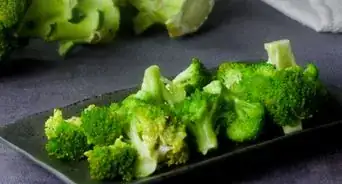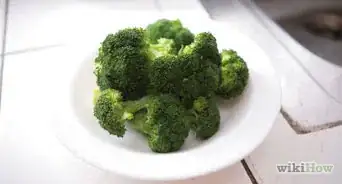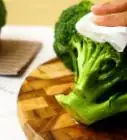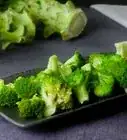This article was co-authored by wikiHow Staff. Our trained team of editors and researchers validate articles for accuracy and comprehensiveness. wikiHow's Content Management Team carefully monitors the work from our editorial staff to ensure that each article is backed by trusted research and meets our high quality standards.
There are 8 references cited in this article, which can be found at the bottom of the page.
This article has been viewed 40,690 times.
Learn more...
Broccoli rabe, also known as rapini (among other names), is a pungent leafy green with small broccoli-like buds. Its ancestors are a wild mustard green, and its flavor is similar to Chinese broccoli, which is a related plant. To clean it, treat it like any dark leafy green, washing it thoroughly to remove any hidden dirt. Afterwards, you can prepare it for cooking by cutting off the bad parts and blanching it in boiling water.
Steps
Washing the Broccoli Rabe
-
1Soak the broccoli rabe in cool water. The best way to clean a leafy green like rabe is to give it a cold water bath. Fill a large bowl with cool water. You can also use a clean sink if you prefer. Dump the rabe in, separating the leaves as you go so dirt can shake loose.[1]
- Alternatively, you can wash the greens under cold, running water. However, submerging them is a safer bet for getting out all the dirt and grit.
-
2Swish the greens around. Once you have the greens submerged, you need to agitate them, much like a washing machine does. Move them around in the water so that the dirt comes away form the leaves and into the water.[2]
- Wash all the crevices in the rabe, including in and around the small buds.
Advertisement -
3Let them sit. Once the you've agitated the rabe for a few minutes, walk away and let them soak. The greens should float to the top, while the dirt should sift to the bottom. Five to ten minutes is sufficient time for them to soak.[3]
-
4Give them another rinse. If the greens are extra dirty, they may need another rinse. Scoop them out, and refill the water. In fact, the rule of thumb used to be three rinses.[4] Modern day produce is generally not as dirty as in the past, but you may still need to rinse it more than once if you got it from the farmer's market.[5]
Drying and Chopping the Broccoli Rabe
-
1Dry the greens. Unless you're blanching or boiling the broccoli rabe, dry it before cooking. You can place the greens in a salad spinner to dry them off. Do it in batches if you need to. An overfilled salad spinner won't get the greens dry.[6] You can also lay them on a paper towel for drying and pat the top with more paper towels.
-
2Slice off the ends of the stems. As with many vegetables, the cut ends of the broccoli rabe may have turned brown in the time the vegetable was in the store. Cut off about an inch of each stem before you start cooking.[7]
-
3Cut off any bad parts. If you notice any parts of the broccoli rabe look bad, don't be afraid to cut that part out. Look for brown or discolored areas, for instance. It's better to throw out areas that you're unsure about, as they can harbor bacteria.[8]
Blanching the Broccoli Rabe
-
1Boil some salted water. Pour water into a pot. Use one tablespoon of salt for a gallon of water. Place it on the stove over high heat, and bring the water to a boil. Also, have a bowl of ice water ready for after you cook the broccoli rabe.[9]
- Many recipes call for the rabe to be blanched before other methods of cooking. The main purpose is to cut some of the bitterness.
-
2Blanch the broccoli rabe. Drop the broccoli rabe in the boiling water, leaving it in the water for about three minutes. Scoop it out, and plunge it in ice water to stop the cooking, swishing it around a bit. Drain it well before you continue cooking it.[10]
-
3Store any you don't cook. If you don't use all of the broccoli rabe in the recipe, you can store the rest of it in the refrigerator. Keep it in a plastic bag. It will stay good for about five days, though it may last a day or two longer.[11] Place a paper towel in the bag to help absorb moisture.[12]
Community Q&A
-
QuestionShould I cook the buds that are hard, or throw them away? I prefer soft buds.
 Community AnswerIf you prefer soft buds, don't cook and eat the hard buds. You can throw them away or compost them.
Community AnswerIf you prefer soft buds, don't cook and eat the hard buds. You can throw them away or compost them. -
QuestionHow do I cook the stems so they're not tough?
 Community AnswerAs far as I know you would just steam them until tender. Unfortunately the remaining green leafy parts will be mushy. You could try cutting off as much of the stem as possible and steaming them for 4-6 minutes, then adding the remaining greens and steam it all to your liking.
Community AnswerAs far as I know you would just steam them until tender. Unfortunately the remaining green leafy parts will be mushy. You could try cutting off as much of the stem as possible and steaming them for 4-6 minutes, then adding the remaining greens and steam it all to your liking.
References
- ↑ https://www.thekitchn.com/quick-tip-how-to-wash-big-load-120416
- ↑ http://www.bonappetit.com/test-kitchen/cooking-tips/article/right-way-wash-fresh-greens
- ↑ https://www.thekitchn.com/quick-tip-how-to-wash-big-load-120416
- ↑ http://www.eatright.org/resource/homefoodsafety/four-steps/wash/washing-leafy-greens
- ↑ http://www.bonappetit.com/test-kitchen/cooking-tips/article/right-way-wash-fresh-greens
- ↑ http://www.bonappetit.com/test-kitchen/cooking-tips/article/right-way-wash-fresh-greens
- ↑ http://www.epicurious.com/recipes/food/views/sauteed-broccoli-rabe-109539
- ↑ http://www.eatright.org/resource/homefoodsafety/four-steps/wash/washing-leafy-greens
- ↑ http://www.epicurious.com/recipes/food/views/sauteed-broccoli-rabe-109539















































